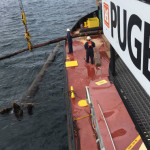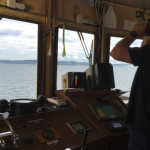Snagboats: Cleaning up after storms since the 1880s
Oct 19, 2016, 5:40 AM | Updated: 9:13 am

Crews on the PUGET have been clearing navigable waterways after storms for decades. (Photo by Feliks Banel)
(Photo by Feliks Banel)
Recent October storms didn’t do much damage on land, but the wind and waves likely set loose dozens of large floating objects, like logs and even old boats. That debris is now making its way into navigable waters in and around Puget Sound and Lake Washington.
If struck by a small craft or even a large commercial vessel, these buoyant hazards can do a lot of damage and even cause injury. Or worse.
Cleaning up the logs, broken docks and other debris around here became the responsibility of the Army Corps of Engineers more than 130 years ago. The main tool for the job is called a “snagboat” – a vessel designed to collect the “snags” (or errant floating logs) created by the countless lumber operations that lined Puget Sound harbors and local rivers in the late 19th century.
Related: Seattle group played pivotal role in healing national wound
Many locals still remember seeing the old steam-powered sternwheeler W.T. PRESTON working along State Route 520 or in Lake Union. It was named for William Trutch Preston, a local pioneer who was head of the Seattle office of the Army Corps of Engineers for many years before passing away in 1919.
The distinctive steamer was a fixture for generations of Puget Sounders who caught glimpses of it as it went about its snagboat duties on local waters from the 1940s to the 1980s.
Even though the PRESTON was retired 35 years ago this month (to become a museum piece in Anacortes), the snagboat tradition has carried on.
On a recent morning, the crew of the PUGET left from a moorage in Ballard and headed off through the locks and out on patrol. The PUGET is a flat-bottomed steel boat, 104 feet long, with a huge crane on its foredeck. It was built during World War II for use in the Pacific as a seaplane tender. It was surplused by the Navy and came to the Northwest in the 1970s.
“Hazards to navigation, that’s what we do,” said Skip Green, captain of the PUGET. “We’re in charge of making sure that all of the navigable waterways are clear – clear of snags for commercial transportation and public transportation. Protect the public, protect the infrastructure.”
Green’s been captain of the PUGET for almost a decade. He says you only have to take a look at any beach on Puget Sound for an idea of where a lot of snags come from.
“You can pretty much go to any shoreline from Olympia all the way up to Blaine and just look and you can see every log,” said Green.
It was worse in the old days, says Ron Burke. He’s a retired architect who for 15 years edited the quarterly journal Sea Chest for the Puget Sound Maritime Historical Society. Burke says that before paved roads, local waterways were the main thoroughfares for passengers and commerce in the 19th and early 20th century Pacific Northwest. The Army Corps of Engineers was the logical entity to keep the passages clear.
“People were farming up on the rivers on the Skagit and Snoqualmie and Nooksack, and there was no way to get their crops down to the market, and there were big logjams in most of the rivers,” said Burke. “People wanted to run steamboats up the rivers but there was just no way to get them up there.”
Burke says the Army Engineers began clearing snags in the waters around what was then Washington Territory in 1883, using a vessel called SKAGIT. It was the first in a long line of local snagboats, including the SWINOMISH, which was renamed the W.T. PRESTON in 1929. That original PRESTON was dismantled in 1939, with much of the gear making its way to the “new” PRESTON in 1940.
Precise teamwork
Back on board the PUGET, we’ve reached Elliott Bay, just south of the Great Wheel on the central waterfront. Binoculars to his eyes, Captain Green spies two giant logs, maybe 70 or 80 feet long, lashed to the end of one of the downtown Seattle piers. He says that construction crews working on the new seawall found the logs bouncing off the pilings and towed them here for Green and the PUGET to collect with the vessel’s powerful crane.
As Green carefully eases the PUGET toward the edge of the pier, crewmember Bob Dunning gets behind the controls of the deck crane and begins directing a large grasping hook called a “grapple” to carefully retrieve the first log and lay it across the deck. Two other crewmen on the deck of the PUGET help guide the log aboard, and then use a huge chainsaw to cut it into smaller sections as Dunning assists with the crane.
“Do you see the bark marks there, right where the crane’s about ready to grab?” Captain Green asks, pointing at one of the huge logs through the window of the wheelhouse. “That’s where a boat’s hit it. See where it looks chopped?
It takes a lot of jockeying and maneuvering to get the massive logs on board, cut into pieces and then stowed in a “crib” on deck. When the work is done, Bob Dunning returns to the wheelhouse to join the watch for the next piece of debris.
Dunning says that the 1970s vintage crane on the deck of the PUGET is just like those typically mounted on trucks for use on land. He says being at sea makes operating the PUGET’s crane a bit more challenging.
“The swing [of the crane] has to be real smooth, that’s pretty much the trickiest part,” said Dunning. “Especially when you get into sea swell and you get a lot of wind and stuff, even with a log in it, and then a ferry swell or a ship swell. That thing really wants to take off.”
All kinds of trees end up as snags in local waters. One variety, in particular, is pretty common and is clearly not a favorite among the PUGET crew.
“Cottonwood is our nemesis, let me tell you,” Captain Green said, groaning. “They’re just bad trees. Cottonwoods are hard to process. We get them on deck, and when you’re cutting them with a chainsaw they have a tendency to want to split and break, and they’re not a rugged wood, and they’re usually waterlogged and they don’t smell nice.”
Related: A look at Seattle’s homeless ‘Shacktown’ history
The tons and tons of logs and other debris retrieved by the PUGET is stored on barges near the Ballard Locks. A few times a year, the old snags are hauled away by trucks and used by public agencies such as the Port of Seattle in habitat restoration projects.
While the crew of the PUGET has their hands full with the demands of doing their dangerous work safely, they also have a sense of the history of their vessel, and of the tradition inherent in the service they’re performing for local boaters.
Bob Dunning knows all about the old W.T. PRESTON and its long history, but he’s just as proud of the PUGET. “[The PUGET is] a piece of history, too,” Dunning said, “And I think we take really good care of it.”
Boat Life
Captain Green clearly admires the PRESTON as well, but he’s also proud of what the PUGET can do. The PRESTON, Green says, wasn’t as nimble. It had a crew of 14 and required a much more laborious and time-consuming process to collect debris.
“We’re a small crew, usually we’re four guys on board,” Green said. “We can grab logs on the fly. There’s just a lot of little things to do, keeping the chainsaws going, keeping the chokers on the deck, grabbing a log that’s floating by.”
The PRESTON also had staterooms and a galley, along with a full-time cook with an assistant. The crew lived aboard as the vessel made its way around the Sound. The galley was famous for its prime rib.
The PUGET takes extended trips to north and south parts of the Sound, and the crew stays onshore in motels. They do eat some meals aboard, but the menu has changed.
“On board the PUGET, we have soup,” Green said, laughing. “Canned soup.”
Ron Burke has researched and written about the PRESTON and about the other snagboats that came before, and he still pays close attention to the contemporary maritime industry. He says the need for the service the PUGET provides is still abundantly clear.
“The traffic on Puget Sound is still there, the ferries are there and the tugs are there,” Burke said, along with all the recreational boat traffic.
Burke laments how much Seattle has moved past and even forgotten about so much of its maritime heritage, something he experienced first-hand. As a young man coming of age around here in the 1950s, Burke put himself through college working on ships.
“I was on six ferries on five different runs, spent a summer on a troop transport to Japan, and spent a few weeks on Puget Sound Freight Lines on one of their little freighters, the S.E. Lovejoy,” said Burke. “And those were all union jobs, good jobs for college kids.”
“In the old days, the Seattle waterfront would have freighters lined up all along it and they’d be in port maybe for a week or two, discharging cargo and taking on new cargo, and of course, the passenger ship [business] to Alaska all went to the airlines.”
“Everything is done with containers now. All the ships are basically foreign-owned, foreign-flagged and foreign-crewed. The ships come in and they swap containers in maybe in just a day or two,” Burke said.
Burke says that the way the maritime industry around Puget Sound has changed is not necessarily for the better.
“I’m prejudiced,” Burke said. “So I would say it’s a great loss.”
Back on board the PUGET, the crew of the snagboat is getting ready to eat some canned soup, and doing their part to keep unchanged a small but essential part of a local maritime tradition.




















